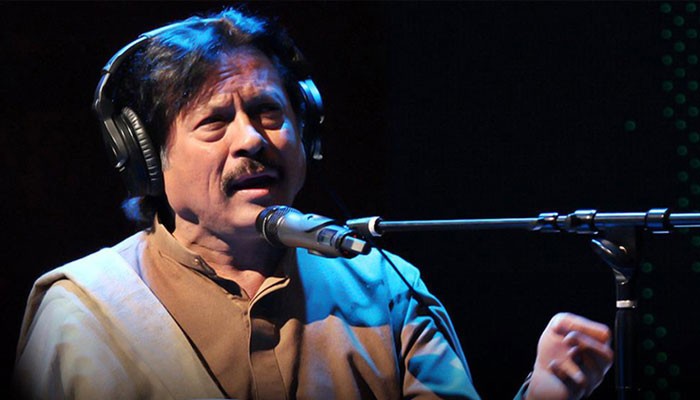
Even though Attaullah Esakhelvi is the authentic voice of the new emerging culture of Pakistan, his contribution is not duly acknowledged

Last week, when the International Music Day was celebrated at the Alhamra, the star of the evening was Attaullah Esakhelvi.
There have been very few vocalists as popular as Attaullah Esakhelvi. He shot to fame in the late 1970s, and for the next couple of decades was hugely popular as a vocalist who performed live. He was accessible back then through cassettes that had become to dominate the music dissemination, displacing the vinyl discs and even the radio. The portability of the transistor radio-cum-cassette player made sure that it was heard in areas where there was no electricity. So, in the streets, mohallas and khokhas and on trucks and buses, Attaullah Esakhelvi reigned supreme. Along with the people in quasi-urban villages and small towns with no pretensions, he became the voice of their expression.
But, despite his popularity, he was neither taken seriously nor was his voice and contribution really acknowledged. He is popular and his omniscience cannot be disputed yet it is dismissed where music is concerned. He is stymied for not singing the real thing. His is seen as a contemporary gloss or veneer on the purely traditional and therefore inauthentic, second-hand or just a mixed-up produce.
It was a relevant debate about three decades ago when the return to the local indigenous or the traditional was linked to the "authentic". The drive was then to be as authentic to the original as possible and those valued in the opinion of the experts were able to achieve it. But over the years the debate or the criticality of it has shifted to the recreation of the older forms and how to make these in sync with contemporaneity.
Usually in Punjab it was kalam of the Sufis that was sung in various forms and listened to with great deal of veneration. But folk music, unless it was a dastaan, like Saiful Malook or Heer, was not taken seriously. The rest was part of frivolity, fun and games and lower level entertainment rather than serious music. The bolis, mahiyas, tappas, dohras were just relished for that instant listening pleasure along with the geet, but musically not rated very high.
So there are a whole lot of reasons why he became popular and, according to some, he became the authentic voice of the new emerging culture of Pakistan. What people had taken to be culture in the past was either urban and sophisticated, with heartstrings attached nostalgically to the Delhi and Lucknow or the traditional culture that took them to the boondocks of village life under the greenwood tree. Those who looked for satisfaction in the western cultural expression wondered what actually their culture was, surrounded by many who lived in the past religiously inspired and wired existence with sneaking glances into the taboo land of culture.
Here was one man who brought the refurbished culture to those living in the borderland of the cities and villages. His lyrics and musical form were not difficult to understand -- they were not rarefied in the poetical idiom of the classics nor were the musical form intricate and difficult to maintain in purity. It was a polyglot, a mixture, a half integrated everything that spoke and expressed itself in a language that was emerging as the lingua franca of the country.
His mahiyas were not what traditional mahiyas were and his tappas were not traditional tappas -- the girl was not from the village -- she was an urban lass with crumbs of education, dreaming of love and upward mobility; the boy not from the mystical tradition reaching out to the spiritual through the flesh. It was all functional without this coming in his way of success, glamour and modernity.
He followed no raag in purity, he followed no form faithfully. His language was not poetical enough -- his was a mixture of an amalgamated stuff. He was able to connect to the amalgamated mass -- his voice heard on the khokhas, in the trucks, in the drawing rooms, in the boys’ hostels because he was what was to be Pakistani -- a whole lot of things, just short of being well cut and polished.
Some have made a name for themselves without hailing from such a background and one of them is Attaullah Esakhelvi. He often talks of the repression, and then his excommunication from the family because of his interest in music. He wanted to become a musicians when the people outside the clan or the community were not supposed to and this often led to disagreements or banishment, if the errand child was not strong enough and surrendered to wishes of the family or even the society at large.
Lord Yehudi Menuhin initiated International Music Day or the IMD on October 1, 1975. It was first organised by the International Music Council on October 1, 1975, in accordance with the resolution taken at the 15th General Assembly in Lausanne in 1973. UNESCO founded the International Music Council (IMC) or the guardian of the IMD in 1949. The IMC is the world’s largest network of organisations, institutions and individuals functioning in the field of music. The International Music Council encourages and fosters musical diversity, access to culture for everyone and unites organisations in some 150 countries worldwide in building peace and understanding among people cutting across class, culture and heritage.